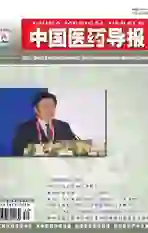角质细胞生长因子活性短肽促进糖尿病大鼠创面愈合的实验研究
2018-01-17宗宪磊曹春艳宋国栋赖晨智余泮熹靳小雷姜笃银
宗宪磊 曹春艳 宋国栋 赖晨智 余泮熹 靳小雷 姜笃银
[摘要] 目的 探讨角质细胞生长因子(KGF)活性多肽对糖尿病大鼠创面愈合的促进作用。 方法 选择24只健康雌性SD大鼠,腹腔注射链脲佐菌素酸(STZ),制备糖尿病大鼠模型。将24只大鼠随机分成4组,即阴性对照组、KGF阳性对照组、KGF活性短肽1组、KGF活性短肽2组,每组6只。分别于大鼠背部制备直径2 cm的圆形创面,并定期对创面局部注射各组药物。伤后14 d进行拍照,记录创面未愈合面积,计算创面愈合率。采用HE染色观察创面愈合情况。 结果 成功制备糖尿病大鼠慢性创面模型。伤后14 d,KGF阳性对照组、KGF活性短肽1组和KGF活性短肽2组的创面愈合率与阴性对照组比较,显著升高,差异有高度统计学意义(P < 0.01);KGF活性短肽1组和KGF活性短肽2组的创面愈合率与KGF阳性对照组比较,差异无统计學意义(P > 0.05)。阴性对照组创面皮肤全层缺失,毛囊、汗腺和皮脂腺等皮肤附件缺失,组织结构均匀致密、无层次,炎症细胞浸润明显。除阴性对照组外,其余各组均创面上皮化良好,深层组织层次清楚、结构疏松,炎症细胞浸润较少,并可见再生的毛囊、汗腺和皮脂腺等皮肤附件。 结论 KGF活性短肽可促进糖尿病大鼠的创面愈合及皮肤附件的再生。
[关键词] 角质细胞生长因子;活性短肽;糖尿病大鼠;创面愈合
[中图分类号] R329.2 [文献标识码] A [文章编号] 1673-7210(2018)10(c)-0004-04
[Abstract] Objective To explore the promoting effect of keratinocyte growth factor (KGF) active peptide on wound healing in diabetic rats. Methods Twenty-four healthy female SD rats were selected, and injected intraperitoneally with streptozotocin to prepare a diabetic rat model. They were randomly divided into 4 groups: negative control group, KGF positive control group, No.1 KGF active short peptide group, and No.2 KGF active short peptide group, with 6 rats in each group. Round wounds of 2 cm in diameter were prepared on the back of the rats, and drugs of each group were injected locally on the wounds. Photographs were taken 14 days after injury, and the unhealed area of the wound was recorded to calculate the wound healing rate. The wound healing was observed by HE staining. Results The chronic wound model of diabetic rats was successfully established. At 14 days after injury, the wound healing rate of KGF positive control group, No.1 KGF active short peptide group and No.2 KGF active short peptide group was significantly higher than that of the negative control group, and the difference was highly statistically significant (P < 0.01). The wound healing rate of No.1 KGF active short peptide group and No.2 KGF active short peptide group was not significantly different from that of KGF positive control group (P > 0.05). In the negative control group, the whole skin of the wound was missing, and the skin attachments such as hair follicles, sweat glands and sebaceous glands were missing. The tissue structure was uniform and dense, no layer, and the inflammatory cell infiltration was obvious. In the other groups, the wounds were well formed, the deep tissue layers were clear, the structure was loose, the infiltrated inflammatory cells was lessen, and the skin attachments such as regenerated hair follicles, sweat glands and sebaceous glands were visible. Conclusion KGF active short peptide can promote wound healing and regeneration of skin attachment in diabetic rats.
[Key words] Keratinocyte growth factor; Bioactive peptide; Diabetic rat; Wound healing
角质细胞生长因子(keratinocyte growth factor,KGF)是一种上皮细胞特异性生长因子,与上皮创面愈合关系密切[1-7]。生长因子产品存在很多缺点,而短肽和多肽具有很多优点[8]。目前,KGF的关键序列已从噬菌体随机7肽库中筛选获得[9-11],并对其进行了KGF活性短肽的合成和离体细胞实验[12]。本研究以SD糖尿病大鼠为研究对象,制备慢性愈合创面模型,探讨KGF活性短肽促进创面愈合的作用。
1 材料与方法
1.1 材料
链脲佐菌素(streptozotocin,STZ)购自美国Sigma公司,KGF购自美国Peprotech公司,KGF活性短肽1(TMRA-KGHLLMF-NH2)和KGF活性短肽2(TMRA-IPTLPSR-NH2)由武汉明皓生物科技有限公司合成。10%水合氯醛、生理盐水、10%甲醛均由中国医学科学院整形外科医院动物实验室提供。
1.2 实验动物与分组
选择24只健康雌性SD大鼠[中国医学科学院整形外科医院动物实验室提供,动物许可证号:SYXK(京)2015-0009],体重约200 g。随机分为4组:阴性对照组、KGF阳性对照组、KGF活性短肽1组,KGF活性短肽2组,每组6只。本研究经实验动物伦理委员会同意。
1.3 糖尿病模型建立
给予SD大鼠55 mg/kg STZ(以0.1 mol/L无菌枸橼酸缓冲液配成10 g/L溶液,pH=4.2)腹腔内注射诱导糖尿病。注射24 h、7 d、14 d后,于大鼠尾靜脉采血检测随机血糖水平并观察体重变化。糖尿病模型成功标准:STZ注射前基础血糖<8.9 mol/L,诱导后血糖水平>11.2 mol/L;并稳定2周。大鼠体重明显下降[13]。
1.4 慢性创面模型建立和干预
糖尿病模型诱导成功1个月后建模。腹腔注射10%水合氯醛4.5 mL/kg麻醉成功后,在背部制备直径2 cm的圆形皮肤全层缺损(图1)。在创面边缘进行多点注射,阴性对照组注射1 mL生理盐水,KGF阳性对照组注射1 mL KGF(5 ng/mL),KGF活性短肽1组注射1 mL KGF活性短肽1(5 ng/mL),KGF活性短肽2组注射1 mL KGF活性短肽2(5 ng/mL)。分别于伤后即刻、3 d、6 d、9 d、12 d进行创面换药和药物注射。药物浓度参照离体细胞实验[12]。
1.5 伤口愈合评价
伤后14 d采用数码照相机拍照;采用铜版纸标记残余的创面;采用称重法计算残余创面面积,计算创面愈合率。创面愈合率=[(原创面面积-残余创面面积)/原创面面积]×100%。创面愈合的标准:创面缩合,完全上皮化,无残存的创面。
1.6 组织学检查
背部创口切取创面及周围组织,用10%甲醛固定,制备成蜡块并切片;切片进行苏木精-伊红(HE)染色,并将其置于显微镜下观察大鼠皮肤缺损后愈合的组织学变化,评价创面愈合效果。
1.7 统计学方法
采用SPSS 17.0统计学软件进行数据分析,计量资料用均数±标准差(x±s)表示,两组间比较采用单因素方差分析法(one-way analysis of variance,ANOVA)和Dunnet′s检验,以P < 0.05为差异有统计学意义。
2 结果
2.1 各组大鼠一般情况观察
注射STZ后,SD大鼠血糖水平>11.2 mol/L,饮食量、尿量明显增多,体重逐渐下降,体质瘦弱,毛发无光泽。伤后14 d,SD大鼠背部的创面清洁干燥无感染,创面结痂。与阴性对照组比较,其余各组SD大鼠的背部创面的面积明显缩小,揭去痂皮,见大部分创面已上皮化。见图1。
2.2 各组大鼠创面愈合率比较
与阴性对照组比较,其余各组伤后14 d的创面愈合率显著升高,差异有高度统计学意义(P < 0.01);与KGF阳性对照组比较,KGF活性短肽1组和KGF活性短肽2组的创面愈合率无显著变化,差异无统计学意义(P > 0.05)。见表1、图2。
2.3 组织学检查
HE染色显示,阴性对照组SD大鼠皮肤全层、毛囊、汗腺和皮脂腺等皮肤附件缺失,组织结构均匀致密、无层次,炎症细胞浸润明显;其余各组创面上皮化良好,可见多层表皮细胞、皮下组织及真皮组织,深层组织层次清楚、结构疏松,炎症细胞浸润较少,可见再生的毛囊、汗腺和皮脂腺等皮肤附件。见图3。
3 讨论
KGF与皮肤创伤愈合密切相关[14-20]。合成的肽具有很多优点,主要包括:①不需要借助动物载体进行生产,避免了伦理学问题和疾病传播;②分子量小,作用单一,方便调整结构,稳定性和性能增强;③方便大量合成,降低生产成本[8]。
本研究以糖尿病大鼠为研究对象,制备慢性创面模型,药物干预后,伤后14 d各组SD大鼠的背部创面均部分愈合,创面清洁干燥无感染,创面结痂,提示观察期适合。与阴性对照组比较,其余各组创面面积明显缩小,大部分创面已经上皮化,提示KGF、KGF活性短肽1和KGF活性短肽2能够显著地促进创面愈合。
与阴性对照组比较,其余各组的创面愈合率显著升高,提示KGF、KGF活性短肽1和KGF活性短肽2能够显著地促进创面愈合,差异有高度统计学意义(P < 0.01);与KGF组比较,KGF活性短肽1组和KGF活性短肽2组促进创面愈合的作用无显著变化。本研究的结果结合细胞实验的结果[12],提示KGF活性短肽1和KGF活性短肽2能够形成KGF的关键的空间构象,与其特异性受体KGFR相结合,从而起到促进创面愈合的作用。
留取伤后14 d的创面标本,进行HE染色检测,结果显示KGF、KGF活性短肽1和KGF活性短肽2能够显著促进创面上皮化,抑制炎性反应,促进深层组织的修复,并能够促进毛囊、汗腺和皮脂腺等皮肤附件的再生。提示KGF活性短肽对创面愈合有多方面的作用,有助于创面恢复正常皮肤的结构和功能。
综上所述,KGF活性短肽能够促进糖尿病大鼠的创面愈合,并能够促进皮肤附件的再生,具有科学研究价值和临床应用前景。
[参考文献]
[1] 宗宪磊,蔡景龙,姜笃银,等.角质细胞生长因子的研究进展[J].中国修复重建外科杂志,2009,23(2):188-193.
[2] Noronha SA,Noronha SM,Lanziani LE,et al. Human beta defensin-4 and keratinocyte growth factor gene expression in cultured keratinocyte and fibroblasts of burned patients [J]. Acta Cir Bras,2014,29 Suppl 3:39-43.
[3] Noronha SM,Noronha SA,Klepp AG,et al. Keratinocyte growth factor,interleukins(1 beta,6,8,10,12),and tumor necrosis factor alpha in culture medium of dermal fibroblast of burned patients [J]. Acta Cir Bras,2014,29 Suppl 1:62-68.
[4] Katsirntaki K,Mauritz C,Olmer R,et al. Bronchoalveolar sublineage specification of pluripotent stem cells:effect of dexamethasone plus cAMP-elevating agents and keratinocyte growth factor [J]. Tissue Eng Part A,2015,21(3-4):669-682.
[5] Yen TT,Thao DT,Thuoc TL. An overview on keratinocyte growth factor:from the molecular properties to clinical applications [J]. Protein Peptide Lett,2014,21(3):306-317.
[6] 缪云萍,叶小弟,程敏,等.重组人角质细胞生长因子-2涂膜剂对家兔损伤创面愈合的影响[J].中华烧伤杂志,2006,22(2):105-108.
[7] Rubin JS,Osada H,Finch PW,et al. Purification and characterization of a newly identified growth factor specific for epithelial cells [J]. Proc Natl Acad Sci USA,1989, 86(3):802-806.
[8] Ahmadvand D,Rasaee MJ,Rahbarizadeh F,et al. Production and characterization of a high-affinity nanobody against human endoglin [J]. Hybridoma(Larchmt),2008,27(5):353-360.
[9] Zong XL,Jiang DY,Wang JC,et al. Keratinocyte growth factor phage model peptides can promote epidermal cell proliferation without tumorigenic effect [J]. Chin Med J,2010, 123(9):1195-1200.
[10] 宗宪磊,蔡景龙,庞力,等.应用噬菌体随机七肽库筛选hFGF-7模拟肽[J].中国修复重建外科杂志,2009,23(2):183-187.
[11] Li GJ,Jiang DY,Zong XL,et al. Keratinocyte growth factor phage model peptides can promote human oral mucosal epithelial cell proliferation [J]. Oral Surg Oral Med O,2013,116(2):e92-e97.
[12] 宗宪磊,陆海滨,祁佐良,等.合成角质细胞生长因子活动短肽促进表皮细胞增殖的实验研究[J].组织工程与重建外科杂志,2016,12(1):1-5.
[13] 王文婷,单菲,王晓川,等.TGF-β1对糖尿病大鼠深Ⅱ度烫伤创面愈合的影像[J].山东大学学报:医学版,2011, 49(7):19-23.
[14] Belleudi F,Scrofani C,Torrisi MR,et al. Polarized endocytosis of the keratinocyte growth factor receptor in migrating cells:role of SRC-signaling and cortactin [J]. PLoS One,2011,6(12):e29 159.
[15] Yamamoto-Fukuda T,Akiyama N,Shibata Y,et al. KGFR as a possible therapeutic target in middle ear cholesteatoma [J]. Acta Otolaryngo,2014,134(11):1121-1127.
[16] Koria P,Yagi H,Kitagawa Y,et al. Self-assembling elastin-like peptides growth factor chimeric nanoparticles for the treatment of chronic wounds [J]. Proc Natl Acad Sci USA,2011,8(3):1034-1039.
[17] Peng C,He Q,Luo C. Lack of keratinocyte growth factor retards angiogenesis in cutaneous wounds [J]. J Int Med Res,2011,39(2):416-423.
[18] Numanolu KV,Tatli D,Bekta S,et al. Efficacy of keratinocyte growth factor (palifermin) for the treatment of caustic esophageal burns [J]. Exp Ther Med,2014,8(4):1087-1091.
[19] Jang JH. Stimulation of human hair growth by the recombinant human keratinocyte growth factor-2 (KGF-2) [J]. Biotechnol Lett,2005,27(11):749-752.
[20] 王澤,黄鹏煌,赵海洋,等.重组人角质细胞生长因子-2对实验秃毛大鼠的毛发再生作用[J].中国药理学通报,2012,28(12):1741-1746.
(收稿日期:2018-08-07 本文编辑:任 念)
